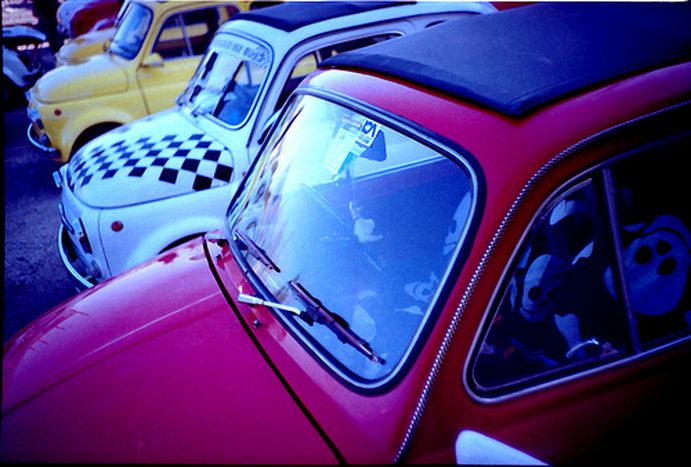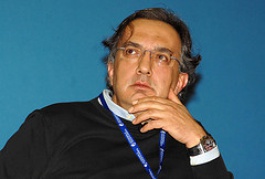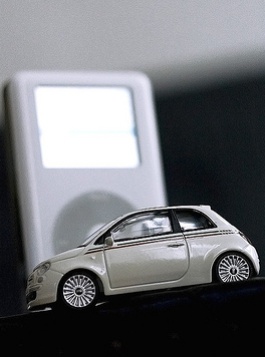
Sergio Marchionne, the man who turned Fiat inside out like a sock whilst listening to Serge Gainsbourg
Published on
Translation by:
Helen SwainA portrait of the man in the jumper who took on the Italian car manufacturer when it was on its last legs and not only transformed it into a champion of the automotive industry, but also obtained an agreement with General Motors
 The man in the jumper is a man of few words. Most of those are in English, the same language in which he thinks, and they are often about numbers. Numbers have made his fortune and that of Fiat ('Fabbrica Italiana Automobili Torino' or the 'Italian automobile factory of Turin'), for which he has been the CEO since 2004, when the Turinese company was on the brink of ruin.
The man in the jumper is a man of few words. Most of those are in English, the same language in which he thinks, and they are often about numbers. Numbers have made his fortune and that of Fiat ('Fabbrica Italiana Automobili Torino' or the 'Italian automobile factory of Turin'), for which he has been the CEO since 2004, when the Turinese company was on the brink of ruin.
Fiat 2009
Five years later, the man in the jumper is the head of a multinational which constantly nibbles away at market shares despite an economic climate unfavourable to the market sector. Nevertheless, the company’s transformation in record time was not painless, involving acquisitions, losses, staff cuts and redundancy payments, even for the white collar workers. The man in the jumper has a reputation for being hard, and he was chosen to orient the business as much as possible to the market and to flexibility.
The man in the jumper has a reputation for being hard
This is also why his very name strikes fear into the industrial district of Lingotto, where the Fiat factory is based. From office number 4.26 Sergio Marchionne has turned Fiat inside out like a sock and designed his ideas for the automobile sector, with the occasional accompaniment of a Serge Gainsbourg song or a classical piece. 'But only if the sound is perfect,' he specifies, in what is almost a pleonasm for one so occupied in pursuing excellence.
Cinquecento = Ipod
 Class of ’54, cosmopolitan, two-thirds European (Italian, Swiss and Canadian), one-third philosopher (his other two degrees are in law and economy and business, plus a masters in business administration), he has a passion – so they say – for poker. ‘But there is poker and poker’ – as he has often declared – ‘I love scientific card games’. Sergio ‘the hammer’, as they call him in Lingotto, came to the world of work late, at 31, when many of his ‘competitors’ already occupied prestigious positions within the great global groups. Instead, the man in the jumper sharpened his weapons for longer, not skimping on training (even now, he wakes up at five am in order to allow himself the luxury of reading the Financial Times, Corriere della Sera, Repubblica, Stampa and Sole 24 ore). He started out only after developing his own way of doing things, far from the dizziness of bright lights and high salaries.
Class of ’54, cosmopolitan, two-thirds European (Italian, Swiss and Canadian), one-third philosopher (his other two degrees are in law and economy and business, plus a masters in business administration), he has a passion – so they say – for poker. ‘But there is poker and poker’ – as he has often declared – ‘I love scientific card games’. Sergio ‘the hammer’, as they call him in Lingotto, came to the world of work late, at 31, when many of his ‘competitors’ already occupied prestigious positions within the great global groups. Instead, the man in the jumper sharpened his weapons for longer, not skimping on training (even now, he wakes up at five am in order to allow himself the luxury of reading the Financial Times, Corriere della Sera, Repubblica, Stampa and Sole 24 ore). He started out only after developing his own way of doing things, far from the dizziness of bright lights and high salaries.
Now, for him, action is a way of life, almost a necessity. He is not one of those referred to when French president Nicolas Sarkozy describes his models: ‘a right-wing man who opens himself up to those who are not part of his tribe’. He is possessed of a Machiavellian pragmatism which hides unexpected depths: with the launch of the 500, Marchionne declared that: 'I would like the Fiat to become the Apple of cars. And the 500 shall be our Ipod'. Touché.
Relaunching the 'Made in Italy' design
 Marchionne is not only known for his collection of sweaters (all bearing little Italian flags, not just an affectation, but also evidence of a patriotism that none of his experiences abroad have managed to efface). His mark is also on the technology and logistical platforms that have allowed Fiat to the gain the contractual power to close acquisitions (for example in the Chrysler affair) at zero cost, combined with an obsession for a typically 'Made in Italy' design, which embodies his ideals of excellence.
Marchionne is not only known for his collection of sweaters (all bearing little Italian flags, not just an affectation, but also evidence of a patriotism that none of his experiences abroad have managed to efface). His mark is also on the technology and logistical platforms that have allowed Fiat to the gain the contractual power to close acquisitions (for example in the Chrysler affair) at zero cost, combined with an obsession for a typically 'Made in Italy' design, which embodies his ideals of excellence.
One need only look at the first pages of the newspaper Usa and Barack Obama’s praise to see that the man in the jumper and the first black American president in history have more in common than just the historical facts of their success stories. Both began with a Yes, we can: ‘The first time I entered Lingotto I smelt a stink of death. Industrial death, I mean. When I showed the triennial objectives people thought I was crazy,' recalls Marchionne. Both believe in change: ‘For me, a Fiat leader must have the capacity to accept change, manage the people who depend on him and convert the twenty thousand intermediate heads of the group.' Orders must be digested, not born. ‘I have always believed that that blue collar workers often suffer the consequences of the white collar workers’ errors, although they are not responsible for those errors.’
'Blue collar workers suffer the consequences of the white collar workers’ errors, although they are not responsible for those errors'
Sergio Marchionne is basically also a romantic. On 14 February 2005, he went to New York – not to canoodle on a bench in Central Park with his darling wife, mother of his two children, but to accomplish the PUT miracle with General Motors, the act which relaunched Fiat as it is today as a group which still has a few aces up its sleeve. However, while it is true that it is a multinational company, it will always remain an Italian company; the cards on the green table for this game beat the Texas Hold’em cards.
Translated from Sergio Marchionne, il “martellatore” in maglione



